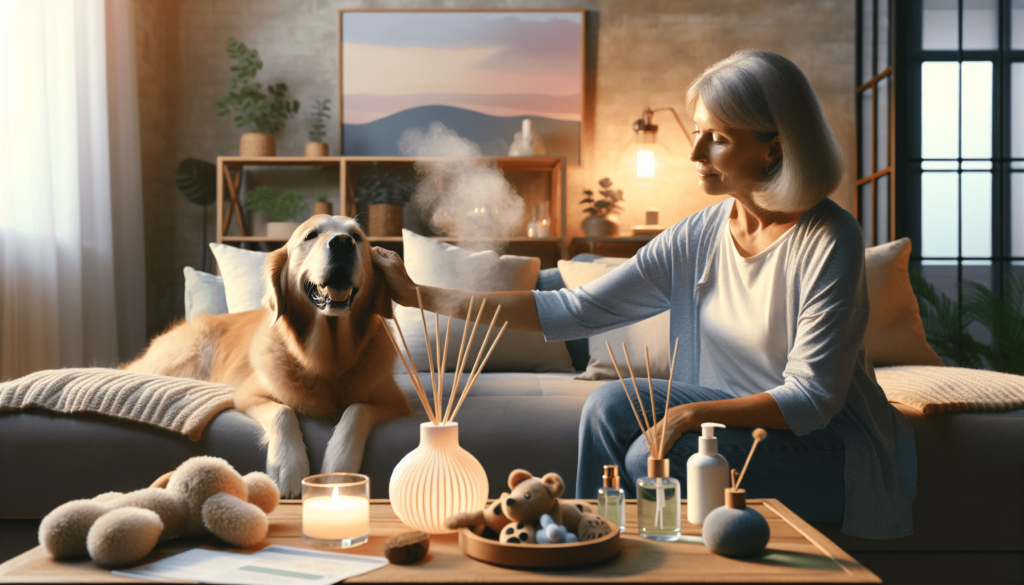If you’ve ever noticed your furry friend trembling, excessively panting, or exhibiting destructive behavior, chances are they may be struggling with dog anxiety. Just like humans, dogs can also experience anxiety and it can affect their overall well-being. But fear not, because in this article we will explore a range of effective strategies that can help you alleviate your canine companion’s anxiety and restore their peace of mind. From creating a safe and comfortable environment to incorporating relaxation techniques, these tried and tested methods are sure to make a positive difference in your pup’s life. So, let’s embark on this journey together and empower you with the knowledge to support your beloved four-legged friend.

Understanding Dog Anxiety
Recognizing the signs of dog anxiety
Understanding the signs of dog anxiety is crucial in order to help your furry friend feel more at ease. Some common signs of anxiety in dogs may include excessive barking, whining, pacing, trembling, panting, restlessness, and destructive behavior. It’s essential to pay attention to your dog’s body language and behavior to identify any signs of anxiety.
Common causes of dog anxiety
Dog anxiety can be triggered by various factors. Some common causes of anxiety in dogs include separation anxiety, loud noises (such as thunderstorms or fireworks), changes in the environment, past traumatic experiences, lack of socialization, and medical conditions. Identifying the root cause of your dog’s anxiety can help you develop effective strategies to manage it.
The impact of anxiety on dogs
Anxiety can have a significant impact on a dog’s overall well-being. Dogs experiencing anxiety may have difficulty relaxing, sleeping, or maintaining a healthy appetite. It can also lead to behavioral problems and poor mental health. Understanding the impact of anxiety on dogs can encourage proactive measures to help alleviate their distress and improve their quality of life.
Creating a Calming Environment
Utilizing crate training
Crate training can provide a safe and secure space for your dog, which can help reduce their anxiety. Introduce crate training gradually, making it a positive experience for your dog. Use treats, toys, and comfortable bedding to make the crate inviting. By associating the crate with positivity, your dog will see it as a calming sanctuary.
Designing a safe space for your dog
Creating a designated safe space for your dog can significantly alleviate anxiety. Choose a quiet and secluded area in your home where your dog can retreat to when feeling anxious. Provide soft bedding, toys, and a comforting scent to make this space inviting and relaxing for your furry friend.
Implementing a consistent routine
Dogs thrive on routine and structure, which can help reduce their anxiety. Establish a consistent daily routine for feeding, exercise, and playtime. This predictability will help your dog feel secure and lessen their anxiety. Stick to regular meal times and exercise schedules to provide a sense of stability for your furry companion.
Physical Exercise and Mental Stimulation
The role of exercise in reducing anxiety
Regular physical exercise is essential for dogs as it releases endorphins, which promote relaxation and reduce anxiety. Engage in daily walks, runs, or play sessions with your dog to burn off excess energy. Exercise also provides mental stimulation and helps distract your dog from anxious thoughts or triggers.
Engaging in interactive playtime
Engaging in interactive playtime is not only a great way to bond with your dog but also helps alleviate anxiety. Play games such as fetch or tug-of-war to keep your dog mentally and physically engaged. Interactive play can redirect your dog’s focus from anxiety-inducing triggers and promote a sense of joy and well-being.
Introducing brain games and puzzles
Mental stimulation is as important as physical exercise in reducing anxiety. Introduce brain games and puzzles that challenge your dog’s mind and keep them mentally engaged. Treat-dispensing toys or puzzle feeders can provide mental stimulation while rewarding your dog’s problem-solving skills.
Positive Reinforcement and Training
Reward-based training methods
Positive reinforcement training methods are highly effective in reducing anxiety and promoting positive behavior in dogs. Reward your dog’s desired behaviors with treats, praise, and affection. This helps build their confidence and creates a positive association with training, thereby reducing anxiety.
Socialization and obedience classes
Proper socialization and obedience training can significantly reduce anxiety in dogs. Expose your dog to various environments, people, and other animals from a young age. Enroll them in obedience classes to build their confidence, improve their social skills, and help them feel more secure in different situations.
Calm and confident handling techniques
Using calm and confident handling techniques can help alleviate your dog’s anxiety. Dogs often look to their owners for cues on how to react in stressful situations. By remaining calm and confident, you can reassure your dog and help them feel more secure. Avoid reacting negatively to their anxious behaviors, as it can reinforce their anxiety.

Natural Remedies and Supplements
Herbal remedies for anxiety
Some herbal remedies, such as chamomile and lavender, have calming properties that can help reduce anxiety in dogs. These herbs can be used in the form of sprays, diffusers, or added to their bedding to create a soothing environment. Always consult with a veterinarian before using herbal remedies to ensure they are safe for your dog.
Therapeutic essential oils
Certain essential oils, such as lavender or frankincense, can have a calming effect on dogs. Dilute these oils with a carrier oil, such as coconut oil, and apply to your dog’s bedding or collar. Use caution and consult with a veterinarian to ensure the oils are safe for your particular dog breed.
Supplements for promoting relaxation
Supplements such as melatonin or L-theanine can help promote relaxation in dogs. These natural supplements can be given orally or incorporated into their diet. Consult with a veterinarian to determine the appropriate dosage and suitability for your dog’s specific needs.
Professional Help and Medication
Consulting with a veterinarian or animal behaviorist
If your dog’s anxiety persists or is severe, it’s essential to seek professional help. A veterinarian or animal behaviorist can help identify the underlying causes of anxiety and develop a comprehensive treatment plan. They may recommend behavior modification techniques, medication, or a combination of both.
Behavior modification techniques
Behavior modification techniques involve gradually exposing your dog to anxiety-inducing triggers and rewarding calm behavior. This process, known as desensitization and counterconditioning, helps your dog build positive associations with previously anxious situations. A professional can guide you in implementing these techniques effectively.
Pharmaceutical options for severe cases
In severe cases of anxiety, medication may be recommended by a veterinarian. Anti-anxiety medications can help regulate your dog’s brain chemistry, reduce anxiety, and improve their overall well-being. Medication should always be prescribed and monitored by a qualified professional.
Desensitization and Counterconditioning
Gradual exposure to anxiety-inducing triggers
Desensitization involves gradually exposing your dog to anxiety-inducing triggers in a controlled and safe manner. Start with low-intensity exposure and gradually increase the intensity as your dog becomes more comfortable. This systematic approach helps your dog develop resilience and reduce their anxiety response.
Association of positive experiences with triggers
Counterconditioning involves associating anxiety-inducing triggers with positive experiences. Pair the trigger with something your dog enjoys, such as treats or playtime. Over time, your dog will start to associate previously anxiety-inducing triggers with positive emotions, thus reducing their anxiety response.
Systematic desensitization and counterconditioning protocols
Implementing a systematic desensitization and counterconditioning protocol can effectively address your dog’s anxiety. This involves creating a step-by-step plan to gradually expose your dog to anxiety triggers while implementing counterconditioning techniques. Seek guidance from a professional to develop a personalized protocol for your dog’s specific needs.
Calming Tools and Products
Thunder jackets and anxiety wraps
Thunders jackets and anxiety wraps, such as the “anxiety wrap” or “calming vest,” can provide gentle pressure on your dog’s body, creating a sense of security and calm. These garments mimic the feeling of being hugged, which can help alleviate anxiety during stressful situations like thunderstorms or fireworks.
Calming pheromone diffusers
Calming pheromone diffusers, such as Adaptil, release synthetic pheromones that mimic the scent of a mother dog. These pheromones have a soothing effect on dogs and can help reduce anxiety. Diffuse the pheromone in areas where your dog spends the most time to create a calming environment.
White noise machines and relaxing music
White noise machines or relaxing music can help drown out external noises that may trigger your dog’s anxiety. These calming sounds create a soothing atmosphere and can help your dog relax. Play white noise or calming music in the background, especially during stressful events or when your dog is left alone.
Reducing Separation Anxiety
Gradual departure and arrival routines
Establishing gradual departure and arrival routines helps reduce separation anxiety. Practice leaving your dog for short periods and gradually increase the duration over time. Keep departures and arrivals low-key, avoiding dramatic exits or returns. This consistency helps your dog feel more secure and less anxious when you’re away.
Safety and comfort measures when left alone
When leaving your dog alone, provide safety and comfort measures to alleviate their anxiety. Leave them with toys, puzzle feeders, or enrichment activities to keep them mentally occupied. Consider using a baby gate or crate to restrict their access to potentially destructive areas. Ensure they have access to water and a cozy space for relaxation.
Professional assistance for severe cases
In severe cases of separation anxiety, professional assistance may be necessary. A veterinary behaviorist or certified dog trainer can help develop a tailored behavior modification plan. They may recommend techniques such as gradual desensitization or medication to manage your dog’s separation anxiety effectively.
Supportive Care and Emotional Well-being
Providing a comforting space for your dog
Creating a comforting space for your dog is essential to their emotional well-being. Provide a cozy bed or blanket where they can retreat when feeling anxious. Make sure the environment is quiet, clean, and free from any potential stressors. This space should be a safe haven where your dog feels secure and at ease.
Emotional support through bonding and affection
Offering emotional support through bonding and affection can significantly reduce anxiety in dogs. Spend quality time with your dog, engaging in activities they enjoy. Regularly pet them, cuddle, and speak to them in a soothing, reassuring tone. This emotional connection helps build a strong bond and provides comfort during anxious moments.
Alternative therapies like massage and acupuncture
Alternative therapies, such as massage or acupuncture, can have a calming effect on anxious dogs. Massage promotes relaxation, releases tension, and soothes anxious muscles. Acupuncture targets specific points in the body to rebalance energy and reduce anxiety. Consult with a qualified professional to explore these alternative therapies for your dog.
By understanding dog anxiety and implementing effective strategies, you can create a calmer and happier environment for your furry friend. Recognizing the signs of anxiety, providing a safe space, engaging in physical exercise and mental stimulation, utilizing positive reinforcement, and considering natural remedies or professional help can make a significant difference in managing and reducing your dog’s anxiety. With your loving care and support, your dog can overcome anxiety and enjoy a well-balanced, anxiety-free life.

